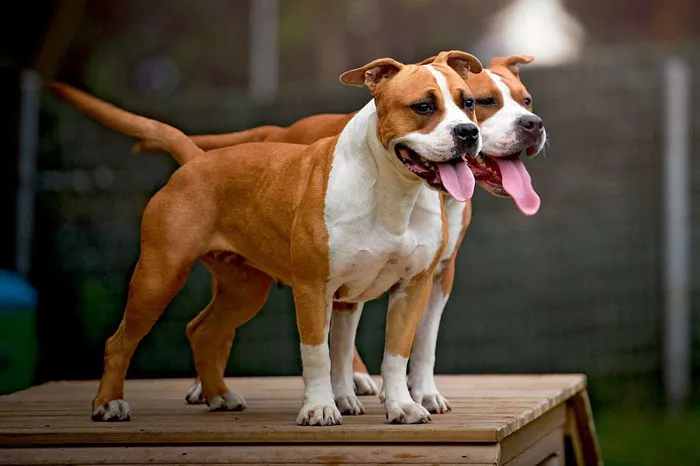The question of whether an American Staffordshire Terrier (American Staff) is a Pit Bull is a topic of confusion for many dog enthusiasts and the general public. Both breeds share similar origins and physical traits, leading to frequent misidentification. However, their histories, breed standards, and roles in society differ significantly. This article explores the relationship between these two breeds, clarifying their distinctions and overlaps through historical context, physical characteristics, temperament, and legal classifications.
Historical Origins: A Shared Past
The Roots of Bull-and-Terrier Crossbreeds
The American Staffordshire Terrier and the Pit Bull (often called the American Pit Bull Terrier) trace their ancestry to 19th-century England. During this period, breeders crossed bulldogs with terriers to create dogs that combined the strength of bulldogs with the agility and tenacity of terriers. These “bull-and-terrier” hybrids were initially bred for blood sports like bull-baiting and dogfighting.
Divergence in Breeding Goals
By the late 1800s, animal welfare laws banned these brutal sports in England. Breeders shifted focus: some aimed to refine the dogs for companionship and show rings, while others continued to emphasize traits for combat. This divergence marked the beginning of two distinct lineages:
American Staffordshire Terrier: Brought to the U.S. in the 1870s, these dogs were selectively bred for a calmer temperament and a bulkier physique. The American Kennel Club (AKC) recognized them as a separate breed in 1936 under the name “Staffordshire Terrier,” later renamed “American Staffordshire Terrier” in 1972 to distinguish them from their British counterparts.
Pit Bull: Dogs retained for fighting or farm work were further developed into the American Pit Bull Terrier, recognized by the United Kennel Club (UKC) but not the AKC. Unlike the AmStaff, Pit Bulls were bred for endurance and a leaner build.
Physical Characteristics: Similarities and Differences
Shared Traits
Both breeds exhibit:
Muscular Build: Compact bodies with pronounced muscle definition.
Short Coat: Easy to maintain, with colors ranging from solid to brindle.
Head Shape: Broad skulls and strong jaws, though the American Staff’s head is slightly larger.
Key Distinctions
| Feature | American Staffordshire Terrier | Pit Bull (American Pit Bull Terrier) |
|---|---|---|
| Height & Weight | 43–48 cm (17–19 inches); 18–23 kg (40–50 lbs) | 45–53 cm (18–21 inches); 14–27 kg (30–60 lbs) |
| Breed Standards | AKC emphasizes a stockier frame and specific coat colors. | UKC allows more variation, including red noses. |
| Bite Force | ~120 kg/cm² | ~126 kg/cm² |
While their appearances overlap, American Staffs are generally heavier and adhere to stricter breed standards, whereas Pit Bulls display greater diversity in size and coloration.
Temperament: Nature vs. Nurture
American Staffordshire Terrier: The “Gentle Giant”
Modern American Staffs are bred for stability and affection. Known as “nanny dogs,” they are loyal, patient with children, and eager to please owners. Proper socialization reduces aggression, making them popular therapy and family dogs. However, their terrier heritage means they retain high energy and a strong prey drive.
Pit Bull: A Misunderstood Reputation
Pit Bulls are often labeled aggressive due to their history in dogfighting. However, studies show that temperament varies widely based on upbringing. Well-trained Pit Bulls can be affectionate, but their genetic predisposition for tenacity and high pain tolerance requires experienced handling.
The Role of Training
Both breeds thrive with consistent training and socialization. Without guidance, either can develop behavioral issues. Notably, American Staffs are more likely to “test boundaries” during training, while Pit Bulls may exhibit stubbornness.
Legal and Cultural Perceptions
Breed-Specific Legislation (BSL)
Many regions, like Wuxi, China, ban both breeds due to their association with aggression. For example, Wuxi’s regulations classify the American Staff and Staffordshire Bull Terrier as “dangerous dogs” alongside Pit Bulls. Such laws often conflate the breeds despite temperament differences.
Media Influence
Negative media coverage of dog attacks frequently misidentifies Pit Bulls, further blurring the line between the two breeds. For instance, incidents involving American Staffs are often wrongly attributed to Pit Bulls.
Conclusion
The American Staffordshire Terrier and Pit Bull share a common lineage but have evolved into distinct breeds through selective breeding. While the American Staff is recognized by the AKC as a show and companion dog, the Pit Bull remains a broader category that includes working and performance lines. Misidentification persists due to physical similarities and societal bias, but understanding their histories and traits is key to responsible ownership.For potential owners, the choice depends on lifestyle: the American Staff suits families seeking a loyal protector, while the Pit Bull demands active engagement to channel its energy. Both require committed training to overcome stereotypes and thrive as beloved pets.
Related Topics:
MOM’S HEARTWARMING STRATEGY TO CHANGE PERCEPTIONS OF HER STAFFORDSHIRE TERRIER
WHAT IS THE AVERAGE LIFESPAN OF A STAFFORDSHIRE TERRIER?
ARE STAFFORDSHIRE BULL TERRIERS PROTECTIVE?


